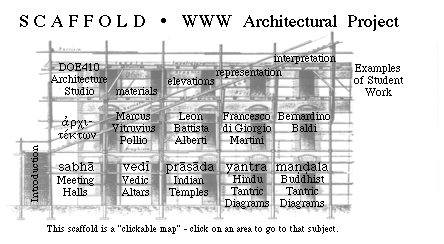
Scaffold: WWW Architectural Project
Introduction
As in the early stages of all architectural projects, the documents in this
scaffold are currently under construction, if not also design. The following is
a brief synopsis of their contents and conditions:
- Indian architecture:
The lower level of the scaffold is devoted to Indian architecture in its various
aspects, a subject that provides both the continually developing foundation for
my own research in architectural history and theory, and a counterpoint to the
western architecture above.
- sabha: Meetings Halls
Due to a lack of archaeological evidence for these secular structures, they
must be reconstructed from sculptural reliefs and textual sources. The images
for this subject have been scanned but the html document is still under
construction.
- vedi: Vedic Altars
To a great extent, the information in this section of the scaffold has been
extracted from chapter 2 of my dissertation, on the
ritual foundations of Indian temple architecture.
- prasada: Indian temples
This html document, currently under construction, is intended is intended to
provide a general introduction to the topic of North Indian temple architecture.
For more detail, particularly on temple construction, see my dissertation.
- yantra: Hindu Tantric Diagrams
The information on yantras here primarily derives from a paper entitled
"Illustrating Occluded Realms: Tantric Geometry and the Approximation of
Perfection" that I presented for the topic "Tantra Occluded: The Unrecognized
Role of Tantra in Asian Culture," held at the annual meeting of the Society for
Tantric Studies, Menlo Park, California, May 28-31, 1992.
- mandala: Buddhist Tantric Diagrams
This study of mandalas is based in part on a course in the construction of the
five mandalas of the Vajrakilaya tradition that I attended at Namgyal Tantric
College, Dharamsala, India, in 1991, and on observation of mandala construction
by various groups of Buddhist monks in India and the United States.
- Classical and Renaissance architecture:
The second level of the scaffold, the "piano nobile," is devoted to some of the
primary sources of western architectural history and theory.
- arxitekton
This section will contain references to architects and architecture in classical
Greek literature. The texts for this subject have been gathered, but the html
document is still under construction.
- Marcus Vitruvius Pollio (c. 90-20 BCE)
This subject currently consists of 12 images scanned from an eighteenth century
Venetian compendium on Vitruvius, from the Perkins Library at the University of
Pennsylvania. The portions of Vitruvius's text that refer to these images will
be added as construction on this html document progresses.
- Leon Battista Alberti (1404-72)
This section of the scaffold, although minimally constructed at this time, has
great "hypertextual" potential, particularly in tracing Alberti's comments on
Vitruvius's treatise.
- Francesco di Giorgio Martini (1439-1501/2)
No mention of Renaissance treatises on architecture would be complete without di
Giorgio's trattato di architettura civile e militare, which provides a
practical counterpoint to the works of both Vitruvius and Alberti. This
document is currently in the planning stages, and will consist of illustrations
from editions of di Giorgio's treatise in the collection of the Perkins Library
at the University of Pennsylvania.
- Bernardino Baldi (1553-1617)
In response to Leon Battista Alberti's comments on Vitruvius's writing style and
use of technical terminology, Bernardino Baldi wrote the first philological
commentary on Vitruvius, entitled de verborum vitruvianorum
significatione. This html document, not yet constructed, will present this
and another work by Baldi, scamilli impares vitruviani, in which Baldi
interprets Vitruvius's use of that term. The illustrations are from a
seventeenth century edition of Baldi's treatise in the collection of the Perkins
Library at the University of Pennsylvania.
- DOE 410 Architecture Studio:
The upper level of the scaffold is devoted to some of the coursework of this
undergraduate architecture studio from the Design of Environment Program in the
College of Arts and Sciences at the University of Pennsylvania.
- Course description
"Architecture (Fall) and Landscape (Spring) Studio. As an introduction to
architecture and landscape design, complex projects explore the interdependence
of building and landscape and engage in perceptual, technical and behavioral
issues: order, light, scale, structure, community and privacy. Projects both
unique and archetypal introduce students to a broad range of questions relevant
to urban, suburban and ex-urban settings."
- Materials
Throughout this course, three lectures will be given on architects, the first of
which is on the work of Josef Plecnik and Sigurd Lewerentz. During this time,
students will be developing the plans of their projects, and thus selected
examples of the work of these architects is presented with emphasis on their use
of materials, particularly applied to floors.
- Elevations
A series of lectures will also be given on building parts throughout this
course, ranging from floors, to walls, to doors and windows, and finally to
ceilings. The second of these, on walls, is given here.
- Representation
The techniques of various media, including pencil drawing, collage, ink, and
watercolor, are also presented in a series of separate lectures. The lecture on
"ink" is here framed by a presentation of the concepts of exactitude, precision,
and accuracy.
- Interpretation
Groups of artists, as well as architects, are discussed in this course. In this
lecture on Andrea Mantegna and Rene Magritte, the problems and possibilities of
interpretation are discussed.
Patrick George's creative website regarding architecture in South Asia
remains a useful and informative resource. Unfortunately, we have no
idea where the author now is or how to make contact with him.